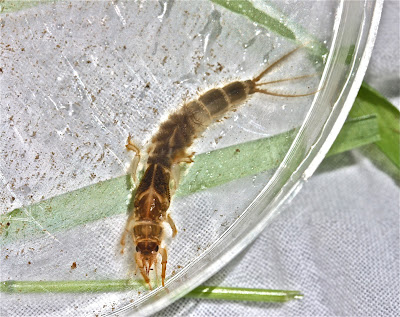Weird -- but beautiful at the same time. This is a "Common Burrower" mayfly nymph, genus Ephemera, species simulans or guttalata. This is a mayfly family we rarely see since it spends most of its time burrowed into the substrate. So, to find them you have to dig, and, as you know, I spend most of my time sifting through leaves and lifting up rocks. But I wasn't alone today -- and my friend is a "digger"! She uses a net to sift through the sand and the silt, and it really paid off. We were working a very small stream in Sugar Hollow, one to which I had not gone before.
The family ID-- Ephemeridae -- is established by the shape of the tusks which "diverge apically" (Beaty, "The Ephemeroptera of North Carolina," p. 44), while the genus ID is determined by the shape of the frontal process: it is not "rounded, conical, or truncate," rather it's "bifid"-- i.e. has two sharp points (Peckarsky, Freshwater Macroinvertebrates, p. 26). Have a look.
On the genus Ephemera, Beaty also notes that the "ventral apex of [the] hind tibia [is] produced into an acute point." (p. 44) While we are looking at the "dorsal" side of the nymph in this photo, we can easily see an "acute point" at the apex of the hind tibia. But this photo also provides evidence for an ID of E. simulans. It has to do with the wing pads. On E. simulans, Beaty notes (p. 44), "both fore- and hind wing pads [are] heavily blotched with irregular dark spots." (Click on the photo to enlarge it.) To have those spots on both sets of wing pads seems to be a feature that only shows up on this species.
Ephemera simulans is an important insect for fly fishermen, especially in the West: it hatches as the "Brown Drake." Consequently, Knopp and Cormier (Mayflies: An Anglers Study of Trout Water Ephemeroptera, pp. 100-101) have a lot to say on this species, including the fact that "Eastern-region brown drake populations are typically sparse and of less significance to the fly fisher." Fishermen would not find any trout in the small stream we went to today! But let me quote them at length on the types of water these insects prefer, and their behavior.
"Brown drake nymphs inhabit slow-moving sections of cold-water streams, rivers, and certain lakes, where they construct U-shaped burrows by digging into substrates of fine sand, gravel, or silt. The purpose of the burrow is not only to safeguard the nymphs from predation but also to provide the photo-sensitive nymphs protection from the sun's rays. Avoiding bright conditions, it is only as evening approaches (or during the afternoon of overcast days) that the nymphs leave the shelter of their burrows to embark on their nightly ventures across the lake or river bottom, returning to the safety of the burrows at dawn."
But the ID of E. simulans is far from certain. A good case could also be made for identifying this nymph as E. guttalata, the "Green Drake." One reason, E. simulans has "dark markings" (Beaty) on the abdominal segments: this nymph does not. (Have a look at the E. simulans nymph at Troutnut.com: http://www.troutnut.com/specimen/91).
Also in favor of an E. guttalata ID -- E. guttalata is primarily found in the East, and, according to Knopp and Cormier (Mayflies, p. 105), "Hatches [of the Green Drake] are particularly prolific on waters flowing from the Appalachian Mountains and southern Ontario drainage systems...".
More work to be done. In the meantime, some more photos of this very interesting find.
__________
We made one other find today that deserves our attention: a very small (4 mm) Chloroperlid (green stonefly) -- genus Haploperla, not Sweltsa. This is a first for me: until now, I've seen nothing but Sweltsa nymphs in our streams.
How does this differ from Sweltsa? It's in the shape of the wing pads. With Sweltsa nymphs, the inner margin of the hind wing pads angle away from the body axis; with Haploperla nymphs, they run parallel to the axis. Here's a microscope view of the wing pads of the nymph in the photo above.
So, another exciting discovery.
Just a few more photos.
1) A flatheaded mayfly, genus Leucrocuta. I haven't seen a lot of this genus this year -- but I always find them in these small streams in Sugar Hollow. (Note the width of the head in relation to the rest of the body.)
2) A pair of Limnephilid (Northern case-maker) caddisfly larvae in pebble cases. I saw at least 30 of these cases today. The leaf packs were loaded with them.
and 3) a very small, immature caddifly larva which I thought was a Wormaldia fingernet caddis. But, seeing the "muscle scars" (dark spots) on the head, I suspect this was a Polycentropodid -- a "trumpetnet" caddis.










No comments:
Post a Comment